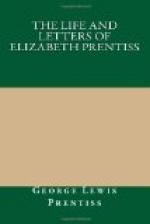And here the end came. Death, if a surprise at all to her, could only be a pleasant surprise. In one of her stories an old family servant says of her departed mistress: “Often’s the time I’ve heard her talk about dying, and I mind a time when she thought she was going, and there was a light in her eye, and it was just as she looked when she said, ’Mary, I’m going to be married.’” It was a leaf out of her own life. She had marked in one of her books of devotion a passage which, I imagine, summed up her view of the whole matter: “A true Christian is neither fond of life nor weary of it.” She had no sentimental disgust with life, but her overmastering desire was to see and be like her Lord, and death was the entrance gate to that perfect vision. Only the opening of that portal could bring the full answer to her prayer of years, “I beseech Thee, show me Thy glory.” In this attitude the messenger found her. I will not dwell on the closing scenes.... It is pleasanter to turn from that long, weary Sabbath, when nature in its perfect beauty and repose seemed to mock the bitter agony of the death-chamber, to the hour when, with the first full brightness of the morning, the silver cord was loosed, and she was present with the Lord. Surely it was something more than an accidental coincidence that, in the little “Daily Food,” which for nearly forty years had been her closet companion, the passage for the 13th of August was: “I heard a voice from heaven saying unto me, Write, blessed are the dead which die in the Lord from henceforth: yea, saith the Spirit, that they may rest from their labors; and their works do follow them.” That summer afternoon when she was laid to rest had a brightness which was not all of the glories of the setting sun, as he burst forth from the encircling clouds, and touched with his parting splendor the gates of the grave. Nature, with its fulness of summer life, was set in the key of the resurrection by the assurance of her victory over death, and it was with a new and mighty sense of their truth that we spoke over her ashes the words of the Apostle: “It is sown in corruption, it is raised in incorruption; it is sown in dishonor, it is raised in glory; it is sown in weakness, it is raised in power; it is sown a natural body, it is raised a spiritual body. O death, where is thy sting? O grave, where is thy victory?”
So now, as then, more even than then, since these months have given us time to study the lesson of that life and the sources of its power, we give thanks to God through Jesus Christ our Lord; thanks for the divine processes which moulded a daughter of consolation; thanks for the fountains of comfort opened by her along life’s highways and which continue to flow while she sleeps in Jesus; thanks for a good and fruitful life ended “in the communion of the Holy Catholic Church, in the confidence of a certain faith, in the comfort of a reasonable, religious, and holy hope, in charity with all mankind, and in peace with God.”




